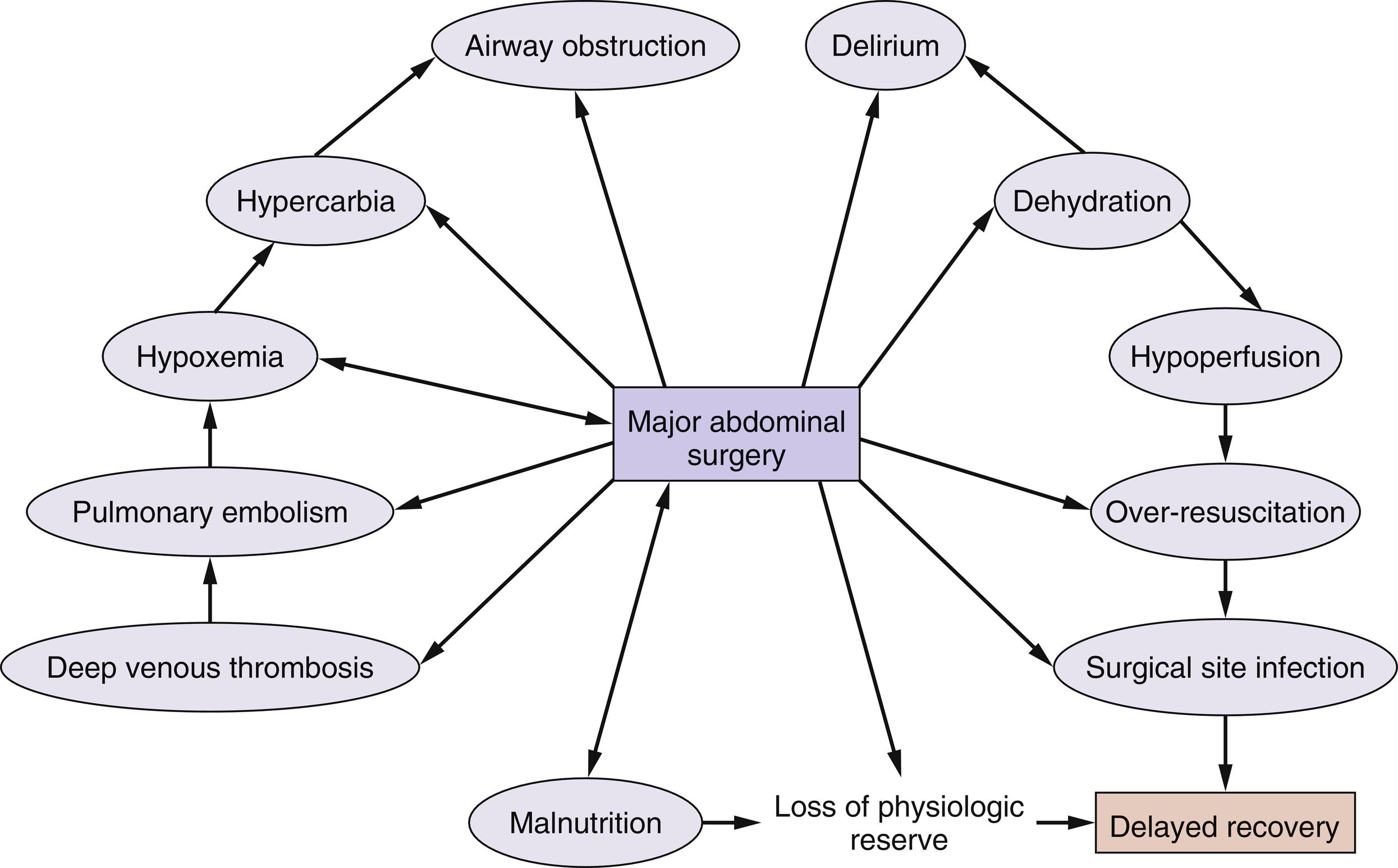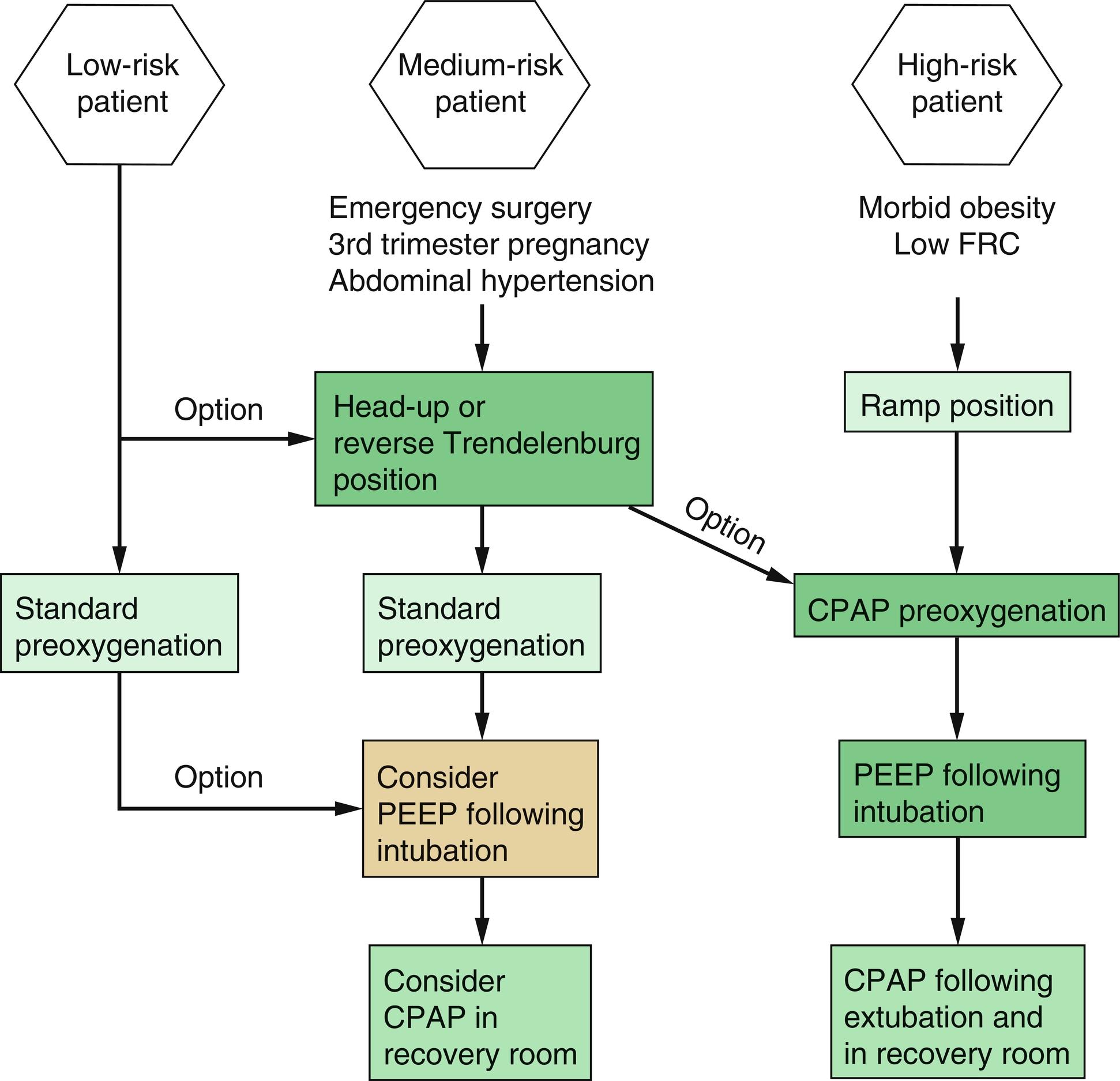Physical Address
304 North Cardinal St.
Dorchester Center, MA 02124
Major abdominal surgery encompasses a broad range of operations with a wide variety of procedures that fall under this category. The perioperative management after a low-risk procedure such as a herniorrhaphy is going to be different from the management following a high-risk procedure such as a pancreaticoduodenectomy. The majority of patients undergoing major abdominal surgery often present with cancer and other medical comorbidities and are put at an elevated risk of a large number of medical and surgical perioperative complications. There are a significant number of factors that make up the risk profile of patients undergoing major abdominal surgery ( Fig. 33.1 ). This elevated risk results from the problem of a significant surgical stress response in older patients with minimal functional or physiologic reserve.

An evidence-based practice that has been gaining momentum in recent years is Enhanced Recovery After Surgery (ERAS). ERAS are evidence-based protocols that seek to standardize perioperative management and have been shown to improve outcomes such as rates of surgical site infections, decrease length of stay, and lower health-care costs. ERAS protocols consist of process measures that aim to decrease the physiologic stress response to surgery and maintain postoperative physiologic function.
In this chapter, we will explore several areas of perioperative management uniquely associated with major abdominal surgery. We will address prevention of pulmonary complications, fluid management strategies, nutrition, and surgical site infections (SSIs). The prevention and treatment of delirium, deep venous thrombosis, and urinary tract infections (UTI) are important in the management of patients following major abdominal surgery and are covered in depth in the other chapters in this textbook.
Patients undergoing major abdominal surgery in particular have an elevated risk of developing pulmonary complications. These include hypoxemia during induction of anesthesia and atelectasis after extubation. Patients undergoing surgery in the upper abdomen and bariatric surgery represent the higher risk cohorts for perioperative pulmonary complications. The closer the operative procedure is to the diaphragm the more likely respiratory compromise is, because postoperative pain will inhibit deep breaths and increase splinting.
Induction of general anesthesia involves the administration of sedative hypnotic drugs and neuromuscular blockers to secure the airway through translaryngeal placement of a cuffed plastic (endotracheal) tube. The major early complications of this process include aspiration of gastric contents, hypoxemia, and failure to obtain an adequate airway. Preoxygenation is widely used to reduce the risk of hypoxemia as a result of airway complications ( Fig. 33.2 ). The principle behind preoxygenation is replacing the nitrogen content of the lungs with oxygen to increase apneic time (i.e., the time between administration of drugs that halt respiration and the restoration of ventilation). However, at the other end of the spectrum, the overuse of oxygen leading to hyperoxia can also cause damage because of oxygen free radicals and increased atelectasis. Oxygen should be titrated to produce normal saturations and arterial oxygen levels, avoiding hyperoxia with prolonged periods of high inspired oxygen.

Other potential problems that occur with induction of anesthesia include decreased functional residual capacity (FRC) and atelectasis. Both neuromuscular blockade and anesthesia induced by sedative hypnotic agents cause significant reduction (16%–20% in the supine position) in FRC. Atelectasis is caused by high inspired oxygen tension (absorption atelectasis) and also results from compression of pulmonary tissue by the heart, particularly the left lower lobe and the juxtadiaphragmatic region (compression atelectasis). The combination of loss of FRC and compressive and absorptive atelectasis commonly results in postintubation hypoxemia and increased airway pressures.
Prolonging apneic oxygenation (the time from onset of apnea until hypoxemia develops) and preventing atelectasis on induction of anesthesia can help prevent some of these problems. Evidence suggests that patient positioning may have a significant impact on the apneic duration in high-risk profile patients, such as pregnant women and the morbidly obese. Intubating patients with the head elevated or in reverse Trendelenburg position is recommended in the majority of patients. Postoperative patient positioning also plays a role in reducing pulmonary complications. The transport of critically ill patients in the semirecumbent position is associated with a lower incidence of nosocomial pneumonia, and maintaining head of bed elevation in mechanically ventilated patients has been demonstrated to increase end expiratory lung volume and reduce respiratory complications. In non-critically ill patients, patient positioning with maintaining head of bed elevation has been demonstrated to reduce postoperative pulmonary complications, especially pneumonia, after major abdominal surgery.
Lung protective ventilation strategy during surgery with low tidal volumes (4 to 5 mL/kg), positive end-expiratory pressure (PEEP) (6 to 8 cm H 2 O) and lung recruitment are associated with improved outcomes. There is considerable evidence that mechanical ventilation with high tidal volumes that cause alveolar stretching can initiate ventilator-associated lung injury. Although lung protective strategies have been routinely accepted in the postoperative phase of care, their usage intraoperatively remains suboptimal.
Other postoperative interventions including head of bed following major abdominal surgery have been demonstrated to reduce pulmonary complications such as pneumonia. These include early mobilization, utilizing regional anesthesia, incentive spirometry, oral hygiene, and smoking cessation. These interventions have been shown to function best as a pulmonary bundle, and all contribute individually toward improving postoperative pulmonary outcomes and should be utilized in postoperative major abdominal surgery patients. Many of these components also align with ERAS recommendations. Early mobilization includes mandatory ambulation in the early postoperative period with “enforced” time out of bed ambulating or in a chair. Prolonged bed rest or immobilization postoperatively is associated with decreased ventilation, atelectasis, and increased rates of pneumonia, and early mobilization has been shown to decrease rates of chest complications. The use of regional anesthesia such as epidural use also has significant benefits to postoperative pulmonary function. Epidural use both reduces opioid use, which has been demonstrated to reduce rates of pneumonia and pulmonary complications, and improves postoperative oxygenation and lung function.
Become a Clinical Tree membership for Full access and enjoy Unlimited articles
If you are a member. Log in here